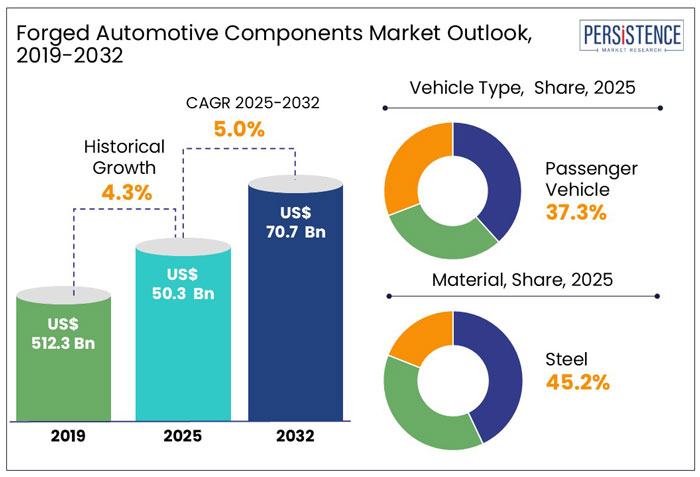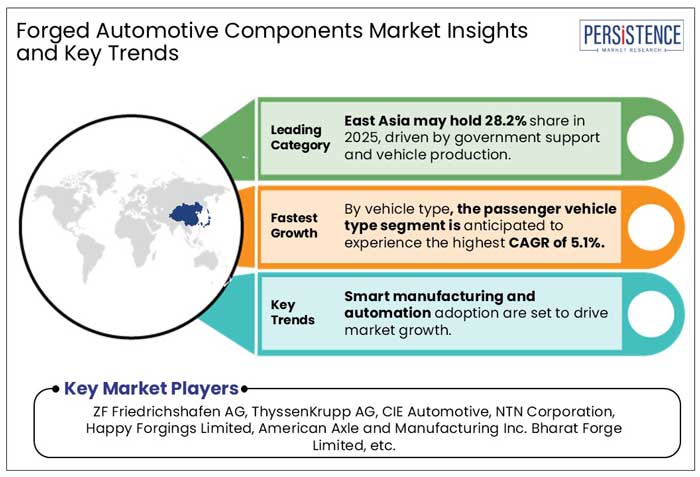ID: PMRREP19672| 225 Pages | 27 Feb 2025 | Format: PDF, Excel, PPT* | Automotive & Transportation

The global forged automotive components market is valued at US$ 50.3 Bn in 2025 and is projected to reach US$ 70.7 Bn by 2032-end, expanding at a CAGR of 5.0% over the next ten years.
Automotive forging components are made using advanced technology that has improved over time to make them stronger, more precise, and affordable. These components help cars perform better and last longer. As cars become lighter and more efficient, forging plays a key role in improving performance and fuel savings.
A key advantage of forged automotive components is their exceptional strength. The forging process aligns the grain structure of the metal, making it denser and more uniform. This alignment enhances the component's ability to withstand high stresses, impact loads, and fatigue, which are prevalent in automotive applications.
The process of forging utilizes compressive force to shape metal, serving as a manufacturing method. Automotive forging is employed in the production of engine parts like connecting rods, injection components, crankshafts, camshafts, pistons, and more. Components like chassis, bearings, gears, and axles are also created through forging. Depending on the desired mechanical properties, forging can be conducted on materials at either high or low temperatures. Forged automotive products offer advantages such as toughness, strength, and high strength-to-weight ratios.
As automakers strive to improve fuel efficiency and reduce emissions, there is a strong emphasis on using lightweight components. Forged automotive components, known for their high strength-to-weight ratios, offer an ideal solution, enabling vehicles to achieve better performance while minimizing weight.
Increasing budget and spending on military requirements in the Asia Pacific region present a significant opportunity for the market. As countries in the region focus on strengthening their defense capabilities, there is a growing demand for advanced military vehicles and equipment. Forged automotive components play a crucial role in the construction of robust and high-performance military vehicles, such as tanks, armored personnel carriers, and artillery systems. Rise in defense expenditure creates a favorable market environment, offering opportunities for manufacturers to cater to the growing demand and supply forged components for military applications.
Additive manufacturing, also known as 3D printing, is gaining traction in the market. This emerging trend allows for the production of complex, lightweight, and highly customized forged components. Additive manufacturing offers design flexibility, enabling the creation of intricate geometries that are difficult to achieve through traditional forging methods.

| Attribute | Details |
|---|---|
|
Forged Automotive Components Market Size (2025) |
US$ 50.3 Bn |
|
Forecasted Market Value (2032) |
US$ 70.7 Bn |
|
Value CAGR (2025 to 2032) |
5.0% |
|
United States Market Value (2032) |
US$ 15.7 Bn |
|
China Market Value (2032) |
US$ 23.2 Bn |
There are three ways that COVID-19 impacted the global economy-fluctuations in manufacturing & demand, supply chain disruptions, and disturbance in the financial stability of companies. Sales of forged automotive components were also affected by the COVID-19 pandemic, as there was a significant drop in the demand for these systems in 2020. Production activities for almost all industries, including manufacturing and transportation, were affected.
The forged automotive components market expanded at a CAGR of 4.3% from 2019 to 2024. Market growth is projected to exhibit a V-shape recovery as economic activities are back to pre-crisis levels post the containment of the pandemic. Over the decade, sales of forged components are expected to rise at a CAGR of 5.0%.
“Rising Safety Regulations and Enhanced Vehicle Performance Requirements”
Forged automotive components provide exceptional strength, durability, and resistance to fatigue, making them well-suited for critical applications. As safety regulations become more rigorous, manufacturers are increasingly adopting forged components to ensure the structural integrity and reliability of vehicles, boosting the demand for these components.
“Increasing Mergers & Acquisitions between Key Manufacturers of Forged Automotive Components for Portfolio Expansion”
Mergers and acquisitions among key market players are allowing them to stay ahead in the market.
“Surging Popularity of Electric & Hybrid Vehicles”
The growing adoption of electric and hybrid vehicles is a key factor driving the forged automotive components market. As the demand for eco-friendly transportation increases, automakers are making significant investments in electric and hybrid vehicle production. These vehicles require lightweight yet durable components to enhance energy efficiency and extend driving range.
Forged automotive components, known for their high strength and weight-saving advantages, are particularly suited for these applications. The shift toward electric and hybrid vehicles is accelerating demand for forged components, driving technological advancements and market expansion.
“Growing Need for Investments in Research & Development Driven by Increasing Demand for Better Ride Quality”
By the end of 2032, the market size is expected to reach US$ 67.8 billion. Growing demand for efficient & reliable forged components with improved safety is the major factor driving the growth of the market. One crucial step for manufacturers of forged components is to prioritize R&D investments to improve the performance and quality of their products.
The automotive industry is witnessing a growing demand for better ride quality, which encompasses factors such as comfort, handling, and overall vehicle dynamics. By investing in R&D, manufacturers can develop innovative solutions and advanced forging techniques that enhance the performance, durability, and reliability of forged components. This includes exploring new materials, optimizing design geometries, and improving manufacturing processes to meet the evolving demands of customers.
“High Initial Investment Required for Forging Facilities and Limited Design Flexibility”
High initial investment required for forging facilities and equipment remains a big challenge for manufacturers. The machinery and infrastructure needed for the forging process can be capital-intensive. This poses a challenge, especially for small- and medium-sized manufacturers or new entrants into the market, who may face difficulties in making the necessary upfront investments. The high cost of entry can act as a barrier, limiting the number of players in the market and potentially impacting its growth.
While forging offers excellent strength and durability, it has some constraints when it comes to complex and intricate component designs. The shaping process in forging is primarily focused on creating solid and robust structures, which may limit the ability to incorporate intricate shapes or intricate internal features that could be achieved through other manufacturing methods. This limitation can restrict design innovation and customization options, particularly in industries where aesthetic or intricate designs are valued.
What is the Current Position of China in the Forged Automotive Components Industry?
“Supportive Government Policies Promoting Increased Vehicle Production”
The market in China is expected to reach US$ 23.2 billion by 2032, expanding at a CAGR of 5%, due to the ever-rising demand for automobiles in the country. The forged automotive components market in China is poised for notable growth as the country experiences an increase in government support and vehicle production.
China's government has introduced various policies and incentives to foster the growth of its automotive industry, particularly in the electric and hybrid vehicle segments. This strategic support is driving increased demand for forged automotive components, which play a crucial role in vehicle manufacturing across multiple categories.
China's thriving automotive industry, marked by a significant increase in vehicle production, fuels the growth of the market. China has emerged as the world's largest automotive market, with high domestic and international demand for vehicles.
What is the Demand Outlook for Forged Automotive Components in the United States?
“High Regulatory Compliance and Vehicle Safety Standards Propelling Demand for Forged Automotive Components”
The forged automotive components industry in the United States is expected to reach US$ 15.7 billion by 2032, expanding at a CAGR of 4.9%. Tightening regulatory standards in the country are playing a significant role in driving market growth by generating demand for compliant forged components.
In the United States, the leading six automotive forging companies include Zetwerk, Sypris Solutions, Powers & Sons, LLC, Aichi Forge USA, LLC, Angstrom-USA, LLC, and American Axle & Manufacturing, Inc. (AAM).
Regulatory standards play a significant role in shaping the automotive industry, particularly in vehicle safety. Stricter regulations compel automakers to enhance safety features and improve structural integrity. Given their exceptional strength and durability, forged automotive components are critical to ensuring vehicle safety and reliability. Consequently, there is a growing demand for forged components that comply with these rigorous safety standards.
Which Vehicle Type Accounts for Extensive Deployment of Forged Components?
“Rising Demand for Forged Automotive Components in Passenger Cars for Enhanced Automotive Safety & Performance”
By vehicle type, passenger cars are expected to dominate the forged automotive components industry. Demand for forged components designed for passenger cars is foreseen to rise at a CAGR of 5.1% from 2024 to 2032.
Passenger cars play a crucial role in the forged automotive components industry due to their diverse component requirements, performance and safety demands, and involvement in light-weighting initiatives. Passenger cars often require high-performance capabilities, precise handling, and safety features. Forged automotive components, known for their strength, durability, and resistance to wear, contribute to meeting these requirements.

The forged automotive components market is moderately fragmented, where tier-I players hold 15% to 20% share of the global market. The automotive forging component market is witnessing steady growth, driven by increasing demand for high-quality forged and precision-machined components. Companies are focusing on expanding their production capabilities, securing long-term contracts, and investing in technological advancements to strengthen their market presence. ThyssenKrupp AG, CIE Automotive, NTN Corporation, American Axle and Manufacturing Inc., and Bharat Forge Limited are among the leading manufacturers of forged automotive components, operating with a vast global presence.
Market participants are strategically emphasizing the introduction of durable and lightweight materials, along with leveraging public and private investments in the automotive sector, to attain higher market shares. As the industry adapts to evolving trends, including the rise of electric vehicles and advanced manufacturing processes, key players are making significant investments to stay competitive. This dynamic landscape highlights the continuous expansion and innovation within the automotive forging sector.
Development:
In July 2023, Talbros Automotive Components secured a multi-year business contract valued at INR 400 Crore (USD 48.4 million). Over the contract term of 5 to 7 years, Talbros will supply gasket, heat shield, forging, and chassis product lines.
By Vehicle Type:
By Automotive Component:
By Material:
By Forging Process:
By Application:
By Region:
The global forged automotive components market is valued at US$ 50.3 Bn in 2025.
Worldwide demand for forged automotive components is predicted to increase at 5.0% CAGR through 2032.
The global market is expected to reach US$ 70.7 Bn by the end of 2032.
Passenger cars account for the most deployment of forged automotive components.
Increasing additive manufacturing and high demand for lightweight components are key market drivers.
ThyssenKrupp AG, CIE Automotive, NTN Corporation, and Bharat Forge account for 17.5% market share.
The United States market is forecasted to advance at a CAGR of 4.9% through 2032.
| Attribute | Details |
|---|---|
|
Base Year for Estimation |
2024 |
|
Historical Data |
2019 to 2024 |
|
Forecast Period |
2025 to 2032 |
|
Quantitative Units |
|
| Report Highlights |
|
|
Key Market Segments Covered |
|
|
Regions Covered |
|
|
Key Countries Covered |
|
|
Key Companies Profiled |
|
|
Customization and Pricing |
Available upon Request |
Delivery Timelines
For more information on this report and its delivery timelines please get in touch with our sales team.
About Author